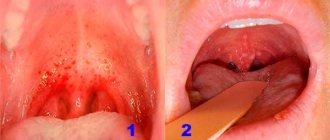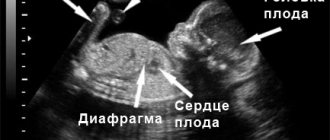Diphtheria is an acute infection, which is characterized by the development of inflammation at the site of penetration and localization of the pathogen. Previously, the incidence among children was high. Mass active immunization (vaccination) has led to a decrease in morbidity. But even now there are sporadic (single) cases of diphtheria, and group outbreaks are possible.
Characteristic of this infectious disease is the formation of a fibrinous dense film at the site of localization of the process and severe intoxication. This quite serious disease can even result in death. How diphtheria occurs in children, what are the main symptoms of this disease and what treatment is prescribed, we will talk in this article.
Causes of the disease
The causative agent of the disease is diphtheria bacillus (Corynebacterium). It is quite stable: it tolerates low temperatures (down to -20°C) and drying; remains for a long time on surrounding objects. But when boiled, the stick dies in one minute, and disinfectants (hydrogen peroxide, chloramine and others) have a detrimental effect on the pathogen within 10 minutes.
The source of infection is a patient with diphtheria or a carrier of the diphtheria bacillus. The latent (incubation) period is usually three days, but can be shortened to two days or extended to ten. The child is contagious from the last day of incubation until final recovery. The bacteria carrier does not have any clinical manifestations of the disease, but spreads the infection.
The airborne route of infection is the main route of infection for diphtheria. Less commonly, infection occurs through contact and household contact (through toys or common objects).
A child can get sick at any age. But infants rarely get sick, since they receive antibodies from their mother’s milk, which provide them with passive immunity. Susceptibility to diphtheria in children is low - up to 15%. Mostly unvaccinated children are affected. There is a winter seasonality of the disease.
The entrance gate for corynebacteria is the mucous membranes of the nasopharynx and larynx. Much less often, the pathogen penetrates through the mucous membranes of the eyes or genital organs, the umbilical wound, and skin with impaired integrity.
At the site of penetration, corynebacteria multiplies and releases exotoxin during life. It has a local effect (causes cell death in tissues at the site of penetration) and a general effect (entering the blood and spreading through the vascular bed). A dense grayish fibrinous film is formed from the affected cells at the site of localization of the inflammatory process.
The general effect of the toxin can result in severe complications: damage to the nervous system and heart muscle. On the part of the heart, myocarditis develops, the heart rhythm is disturbed, and even cardiac arrest may occur. Damage to the nervous system by the toxin leads to impairment of vision, swallowing, and speech. The toxin can cause severe swelling in the neck.
Classification and symptoms of the disease
The causative agent of the disease is corynebacterium (diphtheria bacillus), which tolerates temperatures down to -20 degrees and drying. Can remain on objects for a long time. Kills only from boiling and disinfectants.
The incubation period in children varies from two to seven days. A child can get diphtheria at any age. Diphtheria in young children has a more severe course, as it is accompanied by edema and the development of spasms of the larynx. However, infants are less likely to become infected because they receive the necessary antibodies from their mother’s milk, which provide immunity.
Diphtheria can occur in the following forms:
- diphtheria of the oropharynx;
- nasal diphtheria;
- diphtheria croup (this type of diphtheria occurs more often in children than in adults);
- diphtheria of the eyes;
- skin diphtheria;
- diphtheria of the genital organs;
- mixed forms, when different organs are simultaneously affected by the infection.
Most often, infection occurs in the winter season, through the oropharynx and nasal sinuses. Less commonly through the eyes and skin. Based on localization, a distinction is made between the widespread form of diphtheria and the localized one.
Symptoms of diphtheria in children:
- temperature increase;
- sore throat when eating;
- swelling of the larynx;
- redness of the tonsils and the formation of plaque on them (in the first two days the color of the plaque is white, after which it acquires a gray tint);
- enlarged lymph nodes;
- a gray purulent or bloody substance comes out of the sinuses;
- crusts form on the forehead, cheeks and chins;
- plaque is visible inside the nose;
- swelling of the eyelids, discharge of gray purulent substance from the eyes (difficult to distinguish from conjunctivitis);
- a gray or dirty-tinged coating on the skin;
- in case of skin damage - long healing;
- stomach ache;
- headache.
If a child is vaccinated against diphtheria, then after seven days the disease recedes. In children who have not been vaccinated, it develops into a severe toxic form.
Body temperature can rise to 41 degrees, accompanied by a severe headache. The skin becomes pale. Severe vomiting and abdominal pain may occur. Swelling spreads over the entire surface of the palate and can completely block air access.
Read more about diphtheria vaccination →
Symptoms of diphtheria in children
Considering the localization of the process, diphtheria is distinguished:
- oropharynx;
- larynx;
- eye;
- nose;
- ear;
- umbilical wound;
- wounds;
- genitals.
Oropharyngeal diphtheria
In children, oropharyngeal diphtheria occurs in 95% of cases. It can occur in one of the following clinical forms:
- localized;
- widespread;
- toxic.
The course and nature of the manifestations of the disease depend on the presence of immunization and the age of the child.
In vaccinated children, in rare cases of the disease, diphtheria has a localized, easily occurring form, a favorable outcome (or is expressed in the form of bacterial carriage).
In those who are not vaccinated, the disease is severe, with a high risk of complications and unfavorable outcomes.
The clinical form depends on the age of the children. Newborn babies may develop a process in the umbilical wound; nasal diphtheria develops in infants; after a year, the larynx is more often affected, and after 2 years, as a rule, the process is localized in the pharynx.
The localized form has 3 varieties: catarrhal, island and membranous. The disease begins acutely. The child has a sore throat, the temperature rises to 38°C or 39°C, and the lymph nodes in the neck are enlarged. The inflammatory process is limited to the tonsils.
In the catarrhal form, there is redness of the tonsils, but there are no other changes in the pharynx (plaques, swelling).
In the island form, the onset is acute, with a sore throat and a rise in temperature to 39°C; health, as a rule, suffers slightly. On slightly reddened tonsils, plaque appears in the form of a shiny film of grayish-white or yellowish color with a clear border.
Plaques on the tonsils are located in the form of single or multiple islands. They rise above the level of the tonsil, are difficult to remove when examined with a spatula, and the mucous membrane bleeds after removal. The lymph nodes in the neck are enlarged but painless.
In the filmy form, the plaque covers the tonsil almost completely. At first, the plaque may look like a cobweb-like mesh, later it becomes a dense grayish film with a pearlescent sheen. When the film is forcibly removed, the surface bleeds.
The common form of the disease is reported less frequently. It has a moderate course. The onset is acute, the small patient complains of a sore throat, body temperature is within 39°C. A fibrinous film appears outside the tonsils: on the uvula, palatine arches, and the posterior wall of the pharynx. There is no swelling of the neck. Lymph nodes are enlarged and somewhat painful.
Symptoms of intoxication are typical: the child is inactive, lethargic, has no appetite, and has a headache.
Toxic diphtheria is a severe form of the disease. It develops in unvaccinated children. The beginning is acute. The child has a fever, the temperature rises to high values (up to 40°C). Symptoms of intoxication are significantly pronounced, the patient refuses food. Periods of excitement and inhibition alternate. Severe pallor of the skin, possible vomiting. Due to spasm of the masticatory muscles, it is difficult to open the mouth.
Swelling of the oropharynx, sometimes asymmetrical, is one of the earliest signs of toxic diphtheria. It appears before the formation of the diphtheria film.
The plaque is also translucent at first, but soon it becomes dense, with clear boundaries, and extends beyond the tonsil. When examining the child, a sickly-sweet specific odor from the mouth is felt.
On the 2-3rd day of illness, painless swelling of the subcutaneous tissue of the neck is detected; it may extend lower into the collarbone area. The lower the spread of edema, the more severe the condition of the little patient.
The child's condition is serious. The baby's skin is pale, his lips are dry, his tongue is thickly coated. The neck is thickened. Breathing is noisy. A bloody discharge from the nose may appear. The greatest danger is convulsions.
Diphtheria of the larynx
Young children may develop laryngeal diphtheria , a dangerous complication of which is true croup. Moreover, damage to the larynx can develop in isolation, or it can also occur with diphtheria of another localization, when the films grow and gradually descend into the larynx, block the glottis and make breathing difficult.
There are 3 stages in the development of diphtheria croup:
- stage of croupous cough;
- stenotic;
- asphyxial.
In the stage of croupous cough, against the background of mild intoxication, the temperature rises within 38°C, hoarseness and a dry cough appear. In the future, the rough cough disturbs in the form of attacks and becomes barking.
After 2 or 3 days, the stage of stenosis gradually develops: its main symptom is wheezing. The inhalation becomes long with a noticeable retraction of the intercostal muscles, supraclavicular and subclavian fossae.
The stage of stenosis can last up to three days. At the same time, breathing becomes increasingly difficult, the voice is lost, and signs of respiratory failure develop. The child becomes restless, sleep is disturbed, and the bluishness of the skin increases.
If qualified assistance is not provided, the stage of asphyxia occurs. The child becomes lethargic, breathing becomes less noisy; cyanosis extends to cold extremities; blood pressure decreases; pulse is frequent, weak filling; pupils are wide.
Subsequently, the temperature drops below normal levels, breathing becomes arrhythmic. Uncontrolled urination and bowel movements may occur. Convulsions appear and the child loses consciousness. In the absence of help and surgical intervention, death occurs from asphyxia.
Nasal diphtheria
Nasal diphtheria is recorded more often at an early age. Manifestations of the process are as follows: the temperature is normal or slightly elevated, breathing through the nose is difficult due to swelling of the mucous membrane, and discharge in the form of ichor appears from one nasal passage. The baby's general condition suffers little.
Other types of diphtheria
If hygiene rules are not followed, diphtheria of rare localizations can develop: the ear, eye, umbilical wound, genitals, and skin are affected.
The general condition does not suffer. A gray film forms at the site of the lesion. When the eyes are affected, a unilateral process is characteristic; the film from the conjunctiva can also transfer to the eyeball; the eyelid is swollen.
The skin is affected by diaper rash, wounds, abrasions, and scratches. Swelling of the skin and the formation of a fibrinous grayish film that is difficult to remove appears.
Less common types of disease
There are two secondary forms of the disease.
Subtoxic - pronounced symptoms of intoxication are observed, sore throat intensifies when swallowing. The child often complains of general discomfort. On the tonsils, the coating in the form of a film is more distinct, but, as a rule, does not extend beyond their boundaries. But they acquire a burgundy, purple color. Regional lymph nodes are enlarged with moderate swelling in this area.
Toxic – currently it affects 20% of children from the total number of diseases, including adults. It has a severe course and often develops in unvaccinated children. It has several forms of distribution - localized, widespread and independent. It manifests itself as a sharp rise in temperature to 39–40 degrees a few hours after the onset of the disease.
The little patient experiences general malaise, severe sore throat, and sometimes discomfort in the abdomen or neck. Fever appears, periods of excitement are replaced by lethargy, pronounced pallor of the skin.
With these two types, nausea, vomiting and pain sometimes appear when mouth opening is limited, and hyperemia. On the 2nd–3rd day of illness, painless swelling of the child’s neck appears, which later passes to the collarbone area. There is a sweetish-sweet smell coming from the mouth, and the voice has a nasal note. The more the swelling spreads, the worse the child feels. His neck is thick, his lips are dry, and his tongue is coated. She breathes with some difficulty, and purulent discharge appears from her nose. The most dangerous condition is a seizure.
Complications of diphtheria
The course of diphtheria can be complicated by damage to the kidneys, heart, and nervous system.
Diphtheria is a disease that can lead to very serious complications. In the absence of timely treatment, the toxin of the diphtheria bacillus penetrates into various organs through the bloodstream and can cause toxic shock, damage to the kidneys, myocardium, and peripheral nervous system. Pneumonia often develops with diphtheria croup.
Nephrotic syndrome occurs when the kidneys are damaged. Protein increases in the urine, cylinders and a small amount of formed elements appear. But kidney function is not impaired. Upon recovery, urine analysis returns to normal.
Myocarditis occurs in the second or third week. Moreover, the earlier it manifests itself, the more severe it is and has a worse prognosis. Signs of myocarditis are: increasing severity of the condition and the appearance of various types of cardiac arrhythmias.
Damage to the nervous system with the development of paralysis may appear early (at 2 weeks of illness) and later. The cranial nerves are affected. Paralysis of the soft palate and oculomotor nerves is more common.
Manifestations of these lesions may be:
- choking on food;
- pouring out liquid food from the nasal passages;
- nasal voice;
- deviation of the tongue to the healthy side;
- strabismus;
- swelling of the eyelid on one side.
True croup
After 2–3 days, the stage of stenosis develops; its sign is whistling breathing. The inhalation is long, with retraction of the ribs and collarbones; this stage often lasts up to 3 days. Breathing becomes noisier, the child cannot speak and respiratory failure develops, and the skin has a bluish tint. The child sleeps poorly and becomes restless.
In the absence of medical help, the stage of asphyxia occurs. The child becomes calm, and breathing becomes less noisy, the limbs become cyanotic, and the pressure decreases, the pulse is weak but frequent, the pupils are dilated.
Subsequently, the temperature drops below normal and breathing becomes uneven. Involuntary urination and defecation occur. If convulsions occur, the child may lose consciousness. In the absence of timely assistance, death from asphyxia occurs.
Diagnostics
Diphtheria is diagnosed based on clinical manifestations and laboratory data. Among the clinical symptoms, an important sign for diagnosis is taken into account: the presence of a characteristic dense fibrinous film that is difficult to remove.
Laboratory methods used:
- a blood test to check for the presence of diphtheria antitoxin in the child’s blood;
- bacterioscopic: detection of corynebacteria under a microscope in a smear from the affected area;
- a bacteriological method that allows you to isolate diphtheria bacilli from a smear taken from the affected area.
A fact confirming the diagnosis is also the reverse development of all manifestations of diphtheria just one day after the intravenous infusion of anti-diphtheria serum.
Treatment of diphtheria
At the slightest suspicion of diphtheria, the child is treated only in a hospital setting, and if signs of complications appear, in the intensive care unit.
Treatment of diphtheria in children must be comprehensive. The main and most important method of treatment is the use of anti-diphtheria antitoxic serum. It is administered even if diphtheria is suspected, without waiting for the results of bacteriological culture: this is the only way to avoid serious complications and even save the child’s life. This is due to the fact that the serum neutralizes the effect of the diphtheria bacillus toxin on the child’s body.
Since antitoxic anti-diphtheria serum is prepared on the basis of horse serum, the individual sensitivity of the child’s body to it is checked before its administration. If hypersensitivity is detected, the serum is administered according to a special method in a diluted form.
The serum is administered intravenously. For mild forms it is administered once, and for severe forms it is administered over several days. Doctors are faced with the task of administering the serum as early as possible. The dose of antitoxin is prescribed depending on the severity of the disease, the form of diphtheria and the duration of the disease.
Complex treatment also includes antibiotics, which prevent further spread of the process and to prevent pneumonia. Antibiotics have no effect on the toxin of the diphtheria bacillus, so they are used not instead of anti-diphtheria serum, but in combination with it.
Among the antibiotics used, depending on the prevailing sensitivity of the pathogen, the following drugs are used: Penicillin, Erythromycin, Ampicillin, Gentamicin, Rifampicin, Tetracycline, Ceftriaxone, Ciprofloxacin, Cyprinol and others.
When the larynx is affected, glucocorticoids (Dexamethasone, Prednisolone, Fortecortin, Ortadexon, Novomethasone, etc.) are used as anti-inflammatory drugs. With croup, it is necessary to ensure a flow of fresh air; sedatives and desensitizing agents are also used. If there is a threat of suffocation, surgical intervention - tracheotomy - is used at the stage of stenosis.
Antipyretics (Analgin, Panadol, Paracetamol, etc.), vitamin preparations, and detoxification therapy can be used as symptomatic therapy.
When myocarditis develops, oxygen therapy is used and medications are prescribed to normalize the heart rhythm. For pneumonia, medications that dilate the bronchi are used. With the development of respiratory disorders, the child is transferred to artificial (hardware) respiration.
Caring for a sick child makes a significant contribution to complex treatment. The little patient needs strict bed rest. It is the parents’ task to calm the baby down, give him something to drink, feed, and change clothes on time. If swallowing is impaired, feeding using a nasogastric tube is used.
Non-traditional methods of treating diphtheria can only be used as a means to alleviate sore throat and make the child feel better. For this purpose, you can lubricate your throat with freshly squeezed cranberry juice, gargle with lingonberry, lemon or cranberry juice every half hour. You can lubricate the affected areas with tincture of Rhodiola rosea root or tincture of eucalyptus leaves 3 times a day.
Diphtheria of the eyes, skin, ear, genitals
All these types of diphtheria rarely appear in children, and diphtheria of the ear occurs against the background of infection of the pharynx or nose. The child develops swelling and a grayish coating in the area of infection, and regional lymph nodes become enlarged.
If the genital organs are affected, urination is painful and difficult.
Skin diphtheria occurs at the site of diaper rash, wounds, fungus or ulcers. A serous plaque forms, accompanied by purulent discharge
When the eyes are affected, the process is most often one-sided, the film from the conjunctiva passes to the eyeball, and the eyelid is swollen.
Prevention
Vaccination against diphtheria begins at three months of age.
To prevent diphtheria, the following activities are carried out:
- immunization (vaccination) of the entire population;
- isolation of patients;
- identification, isolation and treatment of diphtheria bacillus carriers;
- monitoring contact children.
A reliable and important preventive measure to protect against diphtheria is vaccination. Vaccinations are carried out with diphtheria (weakened) toxin, which is part of the diphtheria-tetanus-pertussis vaccine (DPT) or diphtheria-tetanus toxoid (DT).
Children are vaccinated from the age of three months: the drug is injected into the muscle three times with an interval of one and a half months. Revaccination is carried out at 1.5-2 years and at 7 and 14 years.
As prescribed by the pediatrician (if the child has contraindications to DPT and ADS), vaccination is carried out with more gentle preparations (they have a reduced antigen content): ADS-M-toxoid or AD-M-toxoid is administered 2 times according to an individual schedule.
On the day of vaccination, the child may experience a rise in temperature, malaise, slight redness and hardness at the injection site.
Patients with diphtheria are isolated for 7 days. Isolation is terminated upon receipt of a negative bacteriological test (smear from the mucous membranes of the nose and throat). Disinfection is carried out at the source of infection. Contact persons are monitored and examined for 7 days (a swab is taken from the nose and throat for bacteriological examination).
Prevention for diphtheria, whooping cough and tetanus - DTP vaccination
An effective means of prevention, tested on hundreds of children and adults, is the DPT vaccination.
It is carried out in the following order:
- 2-3 months after birth;
- at 4-5 months;
- at 6 months - at this stage the primary course ends and the interval between each vaccination should be more than 30 days;
- at 18 months;
- at 6-7 years of age, to restore the activity of the required antibodies, a second vaccine is administered, which differs from the primary one - ADS;
- at 14 years old;
- every next 10 years.
The full course guarantees relative resistance to the diphtheria bacillus. At the same time, cases of infection also occur in fully vaccinated people, but the disease is much milder and does not cause complications.
Indirect prevention of childhood diphtheria will be compliance with hygiene standards. Children aged 3 to 7 years are most susceptible to the disease. It is important to prevent children from coming into contact with people who have had the disease - there is a possibility that the person who has had the disease will be a carrier of the infection without knowing it.
A way to identify and prevent the rapid development of diphtheria is to take a smear test if you have a sore throat or other respiratory disease. The vast majority of cases of infection occur through airborne droplets, so the throat is a vulnerable place for infection.
Large medical, educational and other large-scale institutions impose quarantine when cases of diphtheria infection are detected. Prevention is considered to be isolation and examination of all people in contact with a sick child.
Summary for parents
Diphtheria is a dangerous airborne infection. It can lead to serious complications and even death of the child. If you have the slightest suspicion of this disease, you should immediately consult a doctor. The success of treatment absolutely depends on its timely implementation. You should not refuse the proposed hospitalization of a sick baby.
Diphtheria can be prevented if your child is vaccinated on time. You should not refuse vaccination! After all, it is simply impossible to prevent your beloved child from coming into contact with the diphtheria bacillus bacteria - in transport, in a store, in any group.
Causes of occurrence in childhood
The main reason for the development of diphtheria is the penetration of the pathogen into the body. But not all children become infected. The risk group includes:
- Children 3-6 years old who attend preschool institutions where the likelihood of epidemics is high.
- Children with weakened immunity due to congenital and chronic diseases.
- Children who frequently come into contact with carriers of the pathogen and visit crowded places during the period of peak incidence.
Children 3-6 years old who attend preschool institutions are at risk of diphtheria.
Infants encounter the disease less often, which is explained by the presence of passive immunity, when antibodies enter the body with mother's milk.
The peak incidence occurs in the winter-spring period. It is at this time that the child’s body should be strengthened with the help of vitamins, as well as a balanced diet.
Which doctor should I contact?
At the first signs of diphtheria, it is necessary to call a pediatrician at home, and if the child’s condition is serious, contact an ambulance. Diphtheria is treated by an infectious disease doctor. If various organs are affected, consultations with specialized specialists are prescribed: ophthalmologist, ENT doctor, neurologist, cardiologist, gynecologist, urologist. If necessary, treatment is carried out in an intensive care unit under the supervision of an anesthesiologist-resuscitator.
Rating: (votes - 2 , average: 5.00 out of 5)











